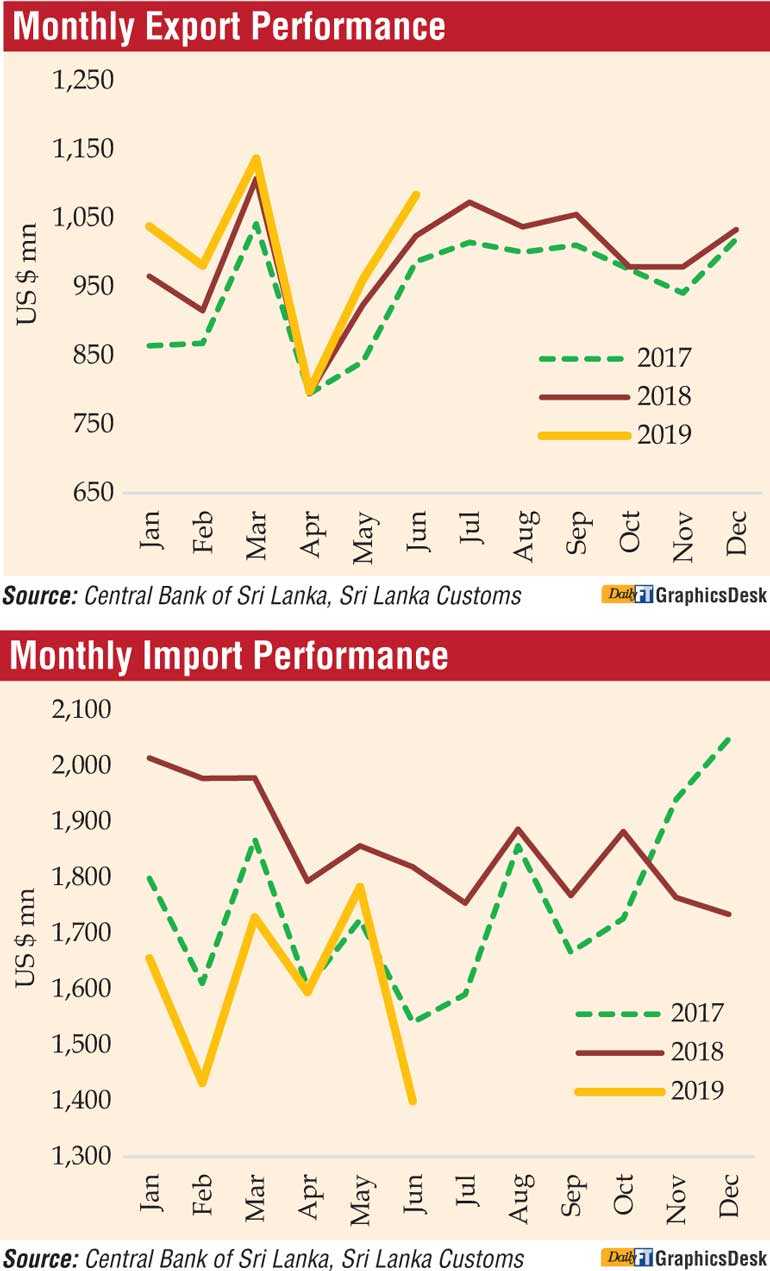Tuesday Apr 23, 2024
Tuesday Apr 23, 2024
Wednesday, 21 August 2019 00:00 - - {{hitsCtrl.values.hits}}

Sri Lanka's trade deficit in the first half has contracted by a whopping $ 2.1 billion, thanks to robust exports and decline in imports.
As per the latest external trade data released by the Central Bank, the deficit in the trade account contracted by $ 2.112 billion to $ 3.6 billion during the first six months of 2019, in comparison to $ 5.7 billion in the corresponding period of 2018.
In June the trade deficit narrowed to $ 316 million, the lowest since October 2010.
Exports in June increased for the 28th consecutive month, with a 5.8% growth to $ 1.08 billion, mainly supported by improved industrial exports.
For the first half of 2019, exports were up 4.7% growth to $ 6 billion.
Imports saw a sharp decline of 23% in June (thereby extending the dip eight consecutive months) to $ 1.4 billion and by 16% to $ 9.6 billion in the first half.
The dip in June was attributed mainly to the reduction in imports of motor vehicles and fuel.
Meanwhile, the terms of trade, which represents the relative price of imports in terms of exports, improved by 3.6% YoY to 114.0 index points in June as export prices, on average, reduced at a slower pace than the decline in import prices. However, on a cumulative basis, the terms of trade deteriorated by 1.5% during the first six months of 2019 in comparison to the corresponding period of 2018.
In June earnings from industrial exports increased in June mainly due to the improved performance in textiles and garments, rubber products and transport equipment. Export earnings from textiles and garments increased by 11.4% in June benefiting from higher demand for garment exports from both the traditional and non-traditional markets.
Export earnings from rubber products increased with better performance in tyres and surgical and other gloves while export earnings from transport equipment increased notably reflecting the supply of a naval craft to Japan. However, export earnings from petroleum products and machinery and mechanical appliances declined significantly in June 2019 in comparison to June 2018.
Earnings from agricultural exports decreased, on a year-on-year basis, in June mainly due to the reduction in earnings from tea, rubber, spices and minor agricultural products. Export earnings from tea declined in June 2019 YoY mainly due to lower prices. However, export earnings from coconut, seafood and vegetables increased in June.
Export earnings from mineral exports also declined in June 2019 in comparison to June 2018.
The export volume index in June increased by 6.4% YoY while the export unit value index declined by 0.6%, indicating that the growth in exports was entirely driven by increased volumes when compared to June 2018.
In June all three major categories of imports; consumer goods, investment goods and intermediate goods contributed to the decline.
Expenditure on consumer goods imports reduced by 39.4% in June, due to lower imports of all subcategories of non-food consumer goods, particularly, personal motor vehicles. The persistent decline in import expenditure on personal motor vehicles mainly reflects the impact of the upward revision of excise duties introduced in March on the importation of hybrid and electric motor vehicles and motor cars with less than 1,000cc engine capacity.
Expenditure on food and beverages imports also decreased reflecting lower outlays in almost all subcategories except seafood, cereals and milling industry products.
Imports of intermediate goods decreased by 11.1% in June mainly due to lower fuel imports. Both crude oil and refined petroleum products declined due to the combined impact of low import volumes and prices. Imports of textiles and textile articles, fertiliser, chemical products, food preparations and paper and paper boards also contributed to the reduction in imports. However, imports of base metals increased in June.
Import expenditure on investment goods decreased in June, due to lower imports in all subcategories. Building material imports reduced mainly due to the decline in iron and steel and cement imports while transport equipment reduced mainly due to the decline in certain categories of vehicles such as commercial cabs, auto trishaws etc.
The import volume index decreased by 19.8% and the unit value index decreased by 4% indicating that the decline in import expenditure was driven by the reduction in both volumes and prices, in comparison to June 2018.